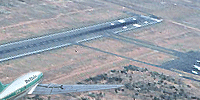 |
 |
|
||||
|
By
Wikipedia,
The Aero 45 was a twin piston-engined civil utility aircraft produced in Czechoslovakia after World War II. It was the first product of the nation's post-war aviation industry and proved a great success, with many of the 590 produced exported. Design and developmentThe development began 1946 and was accomplished by the technical designers Jiři Bouzek, Ondřej Němec and František Vik. The design bears a superficial resemblance, viewed nose-on, to the German Siebel type Si-204 which, among other German aircraft like the Bf 109, were produced in Czechoslovakia while under German occupation. The prototype (registered OK-BCA) flew for the first time on 21 July 1947, the second, registered OK-CDA, one year later. Flight testing ran without incidents and the type was released for series production in 1948. The model number of "45" was not a continuation of Aero's pre-war numeration scheme, but a reference to the 4/5 seats in the aircraft. Operational historyAe-45 prototypes were widely advertised abroad. In August 1949 Jan Anderle won Norton Griffiths Race in Great Britain (Ae-45 registration OK-DCL). They also set several international records. As a result, apart from Eastern Bloc countries, the plane was also bought by Italy and Switzerland. On 10-11 August 1958 an Italian Ae-45 flew 3000 kilometers from South America to Dakar across southern Atlantic (as the first Czechoslovak-built aircraft), in 1981 Jon Svensen flew Ae-45S from Europe to the USA. This type was used in Czechoslovakia and was exported to the People's Republic of China, East Germany, Hungary, Italy, Poland, Romania, Soviet Union and Switzerland. Hungary was a major customer, where the aircraft was known as the Kócsag (Hungarian: "Egret"). Variants
Operators
Civil operators
Military operators
Specifications (Super Aero 45)DescriptionThe Aero 45 had a sleek, teardrop-shaped fuselage, with a rounded, extensively-glazed nose affording excellent visibility. It had a low wing on which the engine nacelles were mounted, and a conventional tail. The main undercarriage was retractable but the tailwheel was fixed. Data from {name of first source} General characteristics
Performance
See alsoComparable aircraft External links
Text from Wikipedia is available under the Creative Commons Attribution/Share-Alike License; additional terms may apply.
Published in July 2009. Click here to read more articles related to aviation and space!
|
||||||||||||||||||||||||||||||||||||||||||||||||||||

 |
|
Copyright 2004-2025 © by Airports-Worldwide.com, Vyshenskoho st. 36, Lviv 79010, Ukraine Legal Disclaimer |